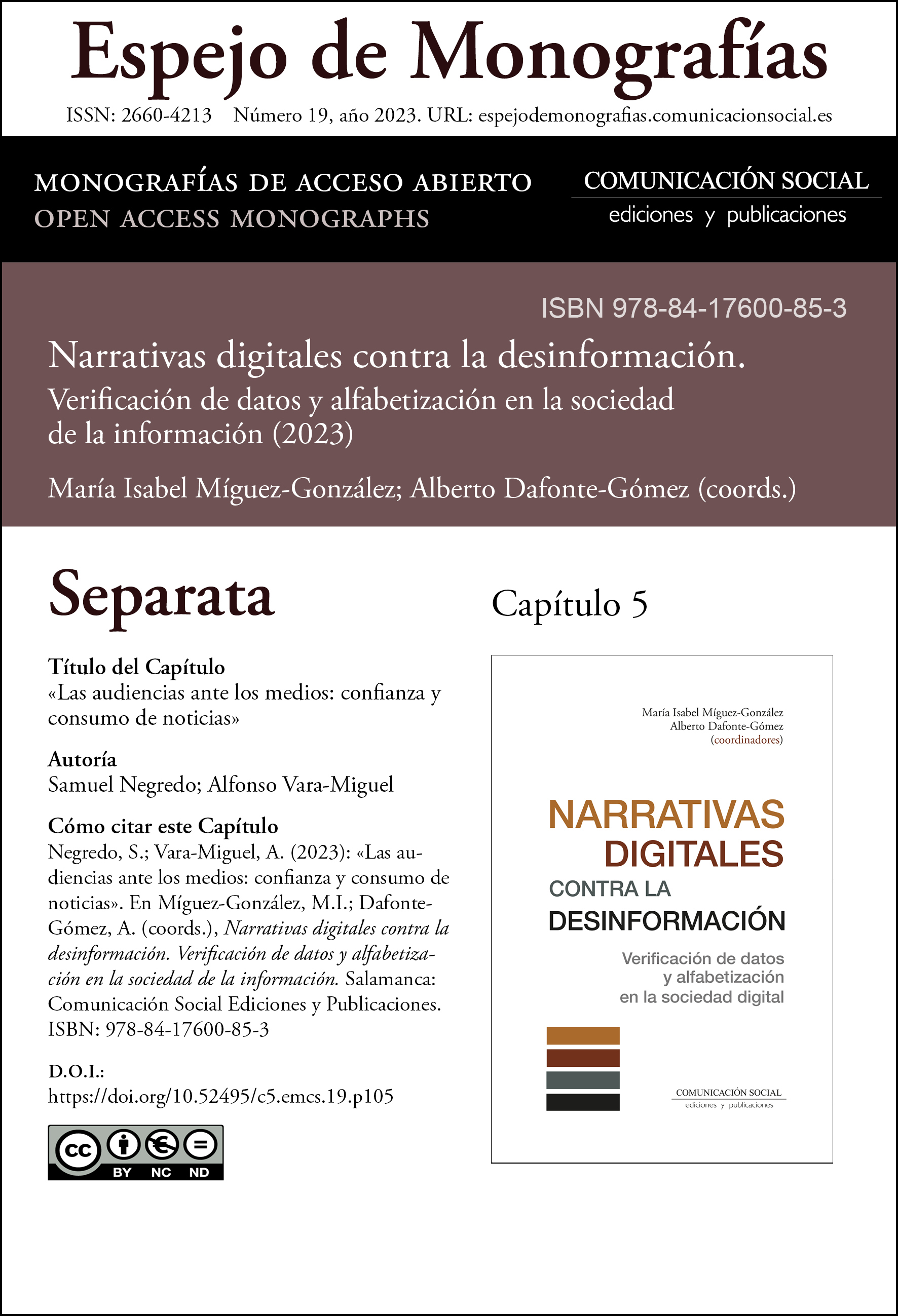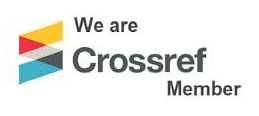Capítulo 5. Las audiencias ante los medios: confianza y consumo de noticias
DOI:
https://doi.org/10.52495/c5.emcs.19.p105Palabras clave:
audiencias de medios, medios digitales, confianza, encuesta, consumo de noticiasResumen
La confianza en los medios de comunicación informativos ha sido un objeto de investigación recurrente en las últimas décadas. Este trabajo repasa algunas aportaciones destacadas, deteniéndose en la relación entre la confianza y los medios que se elige para informarse; en los factores que influyen en ella, y en las implicaciones políticas y sociales de la pérdida de confianza. También presenta resultados de la encuesta Digital News Report, que muestran que en España el interés en las noticias ha decrecido de 2015 a 2022, y los medios periodísticos, tanto tradicionales como digitales, se han visto sustituidos por las redes sociales para el consumo informativo entre muchos adultos jóvenes. Además, las plataformas propiedad de empresas tecnológicas (redes sociales, buscadores y agregadores) compiten con éxito frente a los medios como vías de acceso a las noticias. En este contexto, los adultos españoles que desconfían de las noticias se han ido equiparando a quienes confían en ellas hasta superarlos, salvo en las franjas de población de mayor edad. Esto plantea retos para la defensa de la función democrática de los medios de comunicación periodísticos.
Descargas
Citas
Abel, J.D.; Wirth, M.O. (1977): «Newspaper vs. TV Credibility for Local News». Journalism Quarterly, vol. 54, núm. 2, pp. 371-375. https://doi.org/10.1177/107769907705400223
Adams, J. W. (2006): «Striking it Niche–Extending the newspaper brand by capitalizing in new media niche markets: suggested model for achieving consumer brand loyalty». Journal of Website Promotion, vol, 2, núm. 1-2, pp. 163-184. https://doi.org/10.1080/15533610802104208
Ardèvol-Abreu, A.; Hooker, C. M.; Gil de Zúñiga, H. (2018): «Online news creation, trust in the media, and political participation: Direct and moderating effects over time». Journalism, vol. 19, núm. 5, pp. 611-631. https://doi.org/10.1177/1464884917700447
Bennett, W.L.; Iyengar, S. (2008): «A new era of minimal effects? The changing foundations of political communication». Journal of Communication, vol. 58, núm. 4, pp. 707-731. https://doi.org/10.1111/j.1460-2466.2008.00410.x
Berlo, D.K.; Lemert, J.B.; Mertz, R.J. (1969): «Dimensions for evaluating the acceptability of message sources». Public Opinion Quarterly, vol. 33, pp. 563-576. https://doi.org/10.1086/267745
Coleman, S. (2012): «Believing the news: From sinking trust to atrophied efficacy». European Journal of Communication, vol. 27, núm. 1, pp. 35-45. https://doi.org/10.1177/0267323112438806
Delli Carpini, M.X.; Keeter, S. (1996): What Americans Know about Politics and Why It Matters. New Haven & London: Yale University Press.
Engelke, K.M.; Hase, V.; Wintterlin, F. (2019): «On measuring trust and distrust in journalism: Reflection of the status quo and suggestions for the road ahead». Journal of Trust Research, vol. 9, núm. 1, pp. 66-86. https://doi.org/10.1080/21515581.2019.1588741
Fawzi, N.; Steindl, N.; Obermaier, M.; Prochazka, F.; Arlt, D.; Blöbaum, B.; Dohle, M.; Engelke, K.M.; Hanitzsch, T.; Jackob, N.; Jakobs, I.; Klawier, T.; Post, S.; Reinemann, C.; Schweiger, W.; Ziegele M. (2021): «Concepts, causes and consequences of trust in news media – a literature review and framework». Annals of the International Communication Association, vol. 45, núm. 2, pp. 154-174, https://doi.org/10.1080/23808985.2021.1960181
Fisher, C. (2018): «What Is Meant By ‘Trust’ In News Media?». En: Otto, K., Köhler, A. (eds.): Trust in Media and Journalism. Wiesbaden: Springer, pp. 19-38. https://doi.org/10.1007/978-3-658-20765-6_2
Fisher, C.; Flew, T.; Park, S.; Lee, J.Y.; Dulleck, U. (2021): «Improving Trust in News: Audience Solutions». Journalism Practice, vol. 15, núm. 10, pp. 1497-1515, https://doi.org/10.1080/17512786.2020.1787859
Fletcher, R.; Park, S. (2017): «The Impact of Trust in the News Media on Online News Consumption and Participation». Digital Journalism, vol. 5, núm. 10, pp. 1281-1299. https://doi.org/10.1080/21670811.2017.1279979
Fletcher R.; Nielsen, R.K. (2019): «Generalised scepticism: how people navigate news on social media». Information, Communication & Society, vol. 22, núm., 12, pp. 1751-1769, https://doi. org/10.1080/1369118X.2018.1450887
Gaziano, C.; McGrath, K. (1986): «Measuring the Concept of Credibility». Journalism Quarterly, 63(3) pp. 451-462. https://doi.org/10.1177/
Guess, A.; Nagler, J.; Tucker, J. (2019): «Less than you think: prevalence and predictors of fake news dissemination on Facebook». Science Advances, 5(1). https://www.science.org/doi/10.1126/sciadv.aau4586
Gunther, A.C. (1992): «Biased Press or Biased Public? Attitudes Toward Media Coverage of Social Groups». Public Opinion Quarterly, vol, 56, núm. 2, pp. 147-167. https://doi.org/10.1086/269308
Hanitzsch, T.; Van Dalen, A.; Steindl, N. (2018): «Caught in the Nexus: A Comparative and Longitudinal Analysis of Public Trust in the Press». The International Journal of Press/Politics, vol. 23, núm. 1, pp. 3-23. https://doi.org/10.1177/1940161217740695
Hanusch, F. (2019): «Journalistic Roles and Everyday Life». Journalism Studies, vol. 20, núm, 2, pp. 193-211. https://doi.org/10.1080/1461670X.2017.1370977
Harlow, S.; Salaverría, R.; Kilgo, D. K.; García-Perdomo, V. (2017): «Protest Paradigm in Multimedia: Social Media Sharing of Coverage About the Crime of Ayotzinapa, Mexico». Journal of Communication, vol.67, pp. 328-349. https://doi.org/10.1111/jcom.12296
Henke, J.; Leissner, L.; Möhring, W. (2020): «How can journalists promote news credibility? Effects of evidences on trust and credibility». Journalism Practice, vol. 14, núm. 3, pp. 299-318. https://doi.org/10.1080/17512786.2019.1605839
Horppu, M.; Kuivalainen, O.; Tarkiainen, A.; Ellonen, H. (2008): «Online Satisfaction, Trust and Loyalty, and the Impact of the Offline Parent Brand». Journal of Product & Brand Management, vol. 17, pp. 403-413. https://doi.org/10.1108/10610420810904149
Hovland, C.I.; Weiss, W. (1951): «The Influence of Source Credibility on Communication Effectiveness». Public Opinion Quarterly, vol. 15, pp. 635-650. https://doi.org/10.1086/266350
Johnson, T.J.; Kaye, B.K. (1998): «Cruising is Believing?: Comparing Internet and Traditional Sources on Media Credibility Measures». Journalism & Mass Communication Quarterly, vol. 75, núm. 2, pp. 325-340. https://doi.org/10.1177/107769909807500208
Kiousis, S. (2001): «Public trust or mistrust? Perceptions of media credibility in the information age». Mass Communication & Society, vol. 4, núm, 4, pp. 381-403. https://doi.org/10.1207/S15327825MCS0404_4
Kohring, M.; Matthes, J. (2007): «Trust in News Media: Development and Validation of a Multidimensional Scale». Communication Research, vol. 34, núm, 2, pp. 231-252. https://doi.org/10.1177/0093650206298071
Ladd, J.M. (2012): Why Americans Hate the Media and How It Matters. Princeton University Press. https://doi.org/10.1515/9781400840359
Lazer, D. M. J.; Baum, M. A.; Benkler, Y.; Berinsky, A.J.; Greenhill, M.; Menczer, F.; Metzger, M.J.; Nyhan, B.; Pennycook, G.; Rothschild, D.; Schudson, M.; Sloman, S.A.; Sunstein, C. R.; Thorson, E.A.; Watts, D.J.; Zittrain, J.L. (2018): «The science of fake news: Addressing fake news requires a multidisciplinary effort». Science, vol. 359, núm. 6380, pp. 1094-1096. https://doi.org/10.1126/science.aao2998
Marta Lazo, C.; Farias Batlle, P. (2019): «Information quality and trust: From traditional media to cybermedia». Communication: Innovation & Quality, pp. 185-206.
Mulder, R. (1981): «A Log-Linear Analysis of Media Credibility». Journalism Quarterly, vol. 58, núm. 4, pp. 635-638. https://doi.org/10.1177/107769908105800420
Mutz, D.; Reeves, B. (2005): «The New Videomalaise: Effects of Televised Incivility on Political Trust». American Political Science Review, vol. 99, núm. 1, pp. 1-15. doi:10.1017/S0003055405051452
Oyedeji, T.A. (2007): «The relation between the customer-based brand equity of media outlets and their media channel credibility: an exploratory study». International Journal on Media Management, vol. 9, núm. 3, pp. 116-125.
Park, S.; Fisher, C.; Flew, T.; Dulleck, U. (2020): «Global Mistrust in News: The Impact of Social Media on Trust». International Journal on Media Management, vol. 22, núm. 2, pp. 83-96, https://doi.org/10.1080/14241277.2020.1799794
Strömbäck, J.; Kiousis, S. (2011): «Political Public Relations: Defining and Mapping an Emergent Field». En: Strömbäck, J.; Kiousis, S. (eds.): Political Public Relations. Principles and Applications. Routledge, pp. 1-32.
Strömbäck, J.; Tsfati, Y.; Boomgaarden, H.; Damstra, A.; Lindgren, E.; Vliegenthart, R.; Lindholm, T. (2020): «News media trust and its impact on media use: toward a framework for future research». Annals of the International Communication Association, vol. 44, núm. 2, pp. 139-156. https://doi.org/10.1080/23808985.2020.1755338
Stroud, N.J.; Lee, J.K. (2013): «Perceptions of cable news credibility». Mass Communication & Society, vol. 16, núm. 1, pp. 67-88. https://doi.org/10.1080/15205436.2011.646449
Tandoc, E.C., Ling, R., Westlund, O., Duffy, A., Goh, D.; Zheng Wei, L. (2018): «Audiences’ acts of authentication in the age of fake news: A conceptual framework». New Media & Society, vol. 20, núm. 8, pp. 2745–2763. https://doi.org/10.1177/1461444817731756
Tsfati, Y.; Cappella, J.N. (2003): «Do People Watch What They Do Not Trust?: Exploring the Association between News Media Skepticism and Exposure». Communication Research, vol. 30, núm. 5, pp. 504–529. https://doi.org/10.1177/0093650203253371
Tsfati, Y.; Cappella, J.N. (2005): «Why Do People Watch News They Do Not Trust? The Need for Cognition as a Moderator in the Association Between News Media Skepticism and Exposure». Media Psychology, vol. 7, pp. 251-271. https://doi.org/10.1207/S1532785XMEP0703_2
Tsfati, Y. (2010): «Online News Exposure and Trust in the Mainstream Media: Exploring Possible Associations». American Behavioral Scientist, 54(1), 22-42. https://doi.org/10.1177/0002764210376309
Thorbjørnsrud, K.; Figenschou, T.U. (2022): «The alarmed citizen: Fear, mistrust, and alternative media». Journalism Practice, vol. 16, núm. 5, pp. 1018-1035. https://doi.org/10.1080/17512786.2020.1825113
Waisbord, S. (2018): «Truth is What Happens to News: on journalism, fake news, and post-truth». Journalism Studies, vol. 19, núm. 13, 1866-1878. https://doi.org/10.1080/1461670X.2018.1492881
Westley, B.H.; Severin, W.J. (1964): «Some Correlates of Media Credibility». Journalism Quarterly, vol. 41, núm. 3, pp. 325-335. https://doi.org/10.1177/107769906404100301
Williams, A. E. (2012): «Trust or Bust?: Questioning the Relationship Between Media Trust and News Attention». Journal of Broadcasting & Electronic Media, vol. 56, núm. 1, pp. 116-131, https://doi.org/10.1080/08838151.2011.651186

Publicado
Cómo citar
Número
Sección
Licencia

Esta obra está bajo una licencia internacional Creative Commons Atribución-NoComercial 4.0.
Los artículos publicados en la revista se distribuyen con la Licencia Creative Commons Atribución-NoComercial-SinDerivadas 4.0 Internacional










